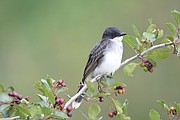Eastern kingbird: An expert at catching flying insects
“The Eastern Kingbird evinces the most daring courage, and gallantly drives off every intruder ... Should he espy a Crow, a Vulture, a Martin, or an Eagle, in the neighbourhood or at a distance, he spreads his wings to the air, and pressing towards the dangerous foe, approaches him, and commences his attack with fury”
— John James Audubon, ornithologist (1785-1851)
The eastern kingbird is a common bird throughout Idaho in open fields and prairies. I typically see them on tree branches, electric lines or fence wires either individually or in small numbers. They have that typical upright stance of flycatchers and they spend a lot of time flying from a perch, catching an insect in flight, and returning to the same perch. They are also very aggressive toward other species. I have seen them harass larger birds such as ravens and hawks.
The eastern kingbird (Tyrannus tyrannus) is a member of the “tyrant” flycatcher family. They are called “tyrant” because of their aggressive response (mobbing) toward other species they consider threats in their territories. The targets of their attacks include others of their own species, crows, hawks, kestrels, snakes and squirrels. They have even been known to knock unsuspecting blue jays out of trees.
Eastern kingbirds are a medium-sized flycatcher with a black head, slate gray back, and a black tail with a broad white terminal band. The bird’s underparts are white with a pale gray wash across its breast. It also has an orange-red crown patch, which is seldom seen, except occasionally during courtship displays or when the bird is in an excited state — for example, chasing potential predators from its territory.
It is the most widespread of the kingbirds throughout North America and inhabits a wide variety of habitats, including open areas such as woodland clearings, roadsides, farmlands and orchards, grasslands with scattered trees and bushes, and openings near water (marshes and ponds).
Eastern kingbirds eat insects during the breeding season and both insects and fruit outside of the breeding season. Insects make up 85 percent of the diet from May to September, including bees and wasps, beetles, grasshoppers, bugs, and flies. Insect prey is mainly taken by hawking from a perch. They dart out from perches to capture flying prey in their air. They will also take insects from the water or ground by hovering or gleaning. Small prey are eaten immediately, larger prey are taken back to the perch and smashed until they are subdued before being eaten. Larger prey are preferred. Fruit is taken in flight while hovering or gleaning as well.
Most predators target eggs and nestlings. Eastern kingbird adults are sometimes taken by aerial predators, such as American kestrels. Eastern kingbirds are aggressive and will energetically attack perceived threats, whenever they are nearby. They will dive at a threat with their crest raised, exposing the red crown feathers, and with the mouth wide open, exposing their bright red gape. They will repeatedly attack the threat until they retreat. Eggs and nestlings are preyed on by crows, ravens, blue jays, squirrels, and small snakes.
The eastern kingbird is most easily identified by its dark gray head and back, pale breast, and black tail with conspicuous white band on tip. This species is most easily distinguished from the related Western Kingbird (Tyrannus verticalis) by that species’ paler body and bright yellow belly. Male and female eastern kingbirds are similar to one another in all seasons.
The maximum longevity for an eastern kingbird is 11.1 years in the wild and they are capable of breading in the first year.
Enjoy Boundary County and all its wildlife!
• • •
Note: A photo correction for the July 23 “Outdoor Column”: The photos were of Tiger lilies or Columbia lilies (Lilium columbianum), not Glacier lilies (Erythronium grandiflorum). I apologize for any confusion this may have caused.



